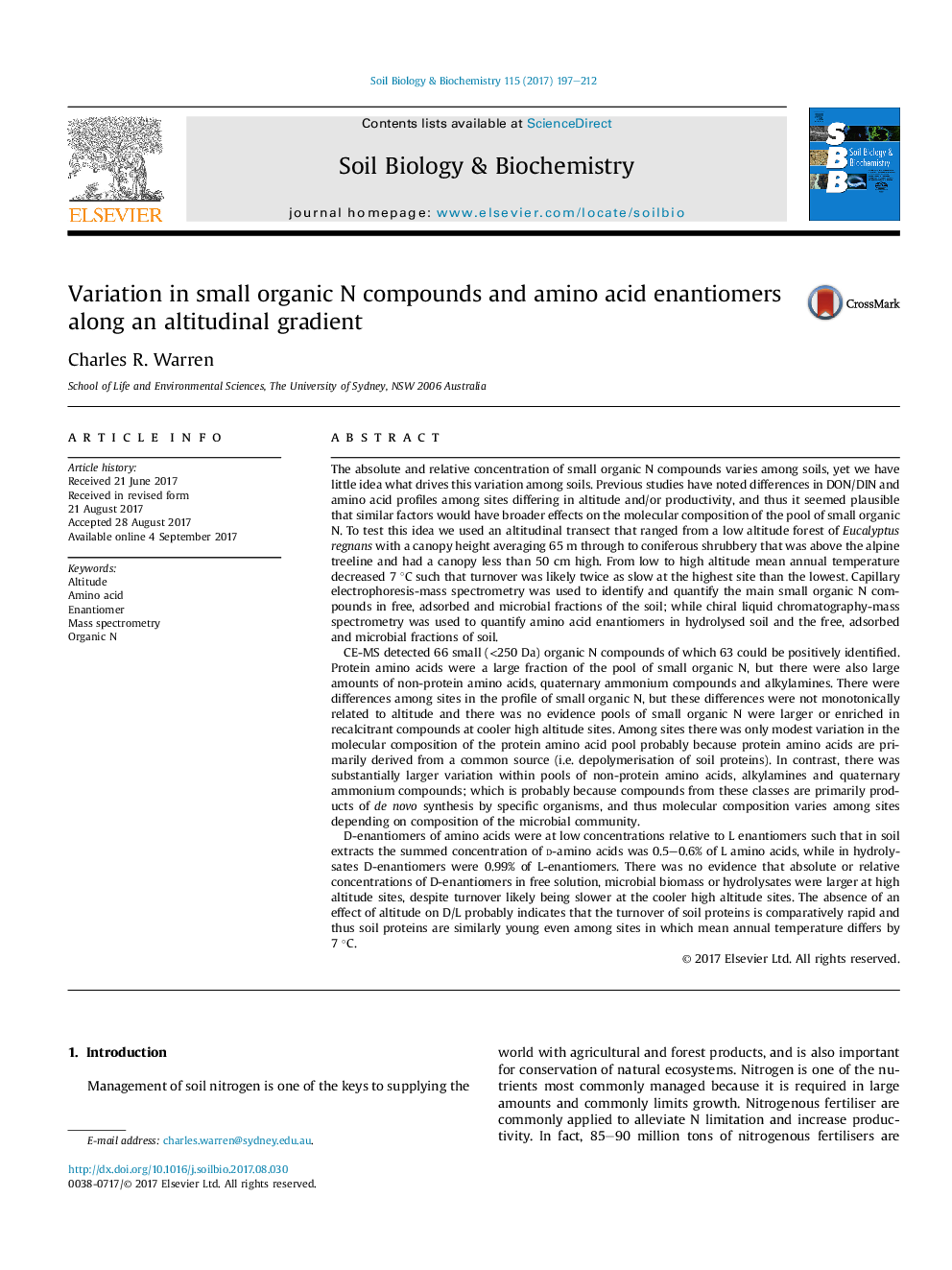| کد مقاله | کد نشریه | سال انتشار | مقاله انگلیسی | نسخه تمام متن |
|---|---|---|---|---|
| 5516241 | 1542569 | 2017 | 16 صفحه PDF | دانلود رایگان |
- We measured small organic N across an altitudinal transect.
- Small organic N differed among sites, but pools were not consistently larger at higher altitude.
- There was small variation in molecular composition of the protein amino acid pool.
- Other classes of small organic N were abundant and varied enormously among sites.
- d-amino acids were present at low concentrations and did not vary with altitude.
The absolute and relative concentration of small organic N compounds varies among soils, yet we have little idea what drives this variation among soils. Previous studies have noted differences in DON/DIN and amino acid profiles among sites differing in altitude and/or productivity, and thus it seemed plausible that similar factors would have broader effects on the molecular composition of the pool of small organic N. To test this idea we used an altitudinal transect that ranged from a low altitude forest of Eucalyptus regnans with a canopy height averaging 65 m through to coniferous shrubbery that was above the alpine treeline and had a canopy less than 50 cm high. From low to high altitude mean annual temperature decreased 7 °C such that turnover was likely twice as slow at the highest site than the lowest. Capillary electrophoresis-mass spectrometry was used to identify and quantify the main small organic N compounds in free, adsorbed and microbial fractions of the soil; while chiral liquid chromatography-mass spectrometry was used to quantify amino acid enantiomers in hydrolysed soil and the free, adsorbed and microbial fractions of soil.CE-MS detected 66 small (<250 Da) organic N compounds of which 63 could be positively identified. Protein amino acids were a large fraction of the pool of small organic N, but there were also large amounts of non-protein amino acids, quaternary ammonium compounds and alkylamines. There were differences among sites in the profile of small organic N, but these differences were not monotonically related to altitude and there was no evidence pools of small organic N were larger or enriched in recalcitrant compounds at cooler high altitude sites. Among sites there was only modest variation in the molecular composition of the protein amino acid pool probably because protein amino acids are primarily derived from a common source (i.e. depolymerisation of soil proteins). In contrast, there was substantially larger variation within pools of non-protein amino acids, alkylamines and quaternary ammonium compounds; which is probably because compounds from these classes are primarily products of de novo synthesis by specific organisms, and thus molecular composition varies among sites depending on composition of the microbial community.D-enantiomers of amino acids were at low concentrations relative to L enantiomers such that in soil extracts the summed concentration of d-amino acids was 0.5-0.6% of L amino acids, while in hydrolysates D-enantiomers were 0.99% of L-enantiomers. There was no evidence that absolute or relative concentrations of D-enantiomers in free solution, microbial biomass or hydrolysates were larger at high altitude sites, despite turnover likely being slower at the cooler high altitude sites. The absence of an effect of altitude on D/L probably indicates that the turnover of soil proteins is comparatively rapid and thus soil proteins are similarly young even among sites in which mean annual temperature differs by 7 °C.
Journal: Soil Biology and Biochemistry - Volume 115, December 2017, Pages 197-212
